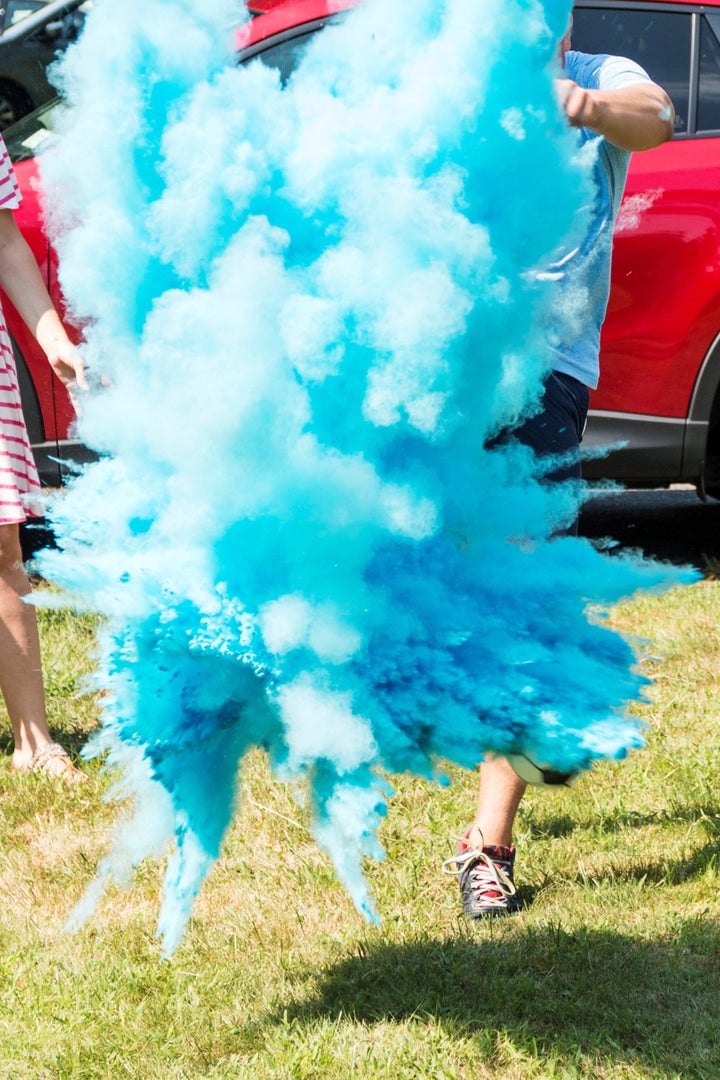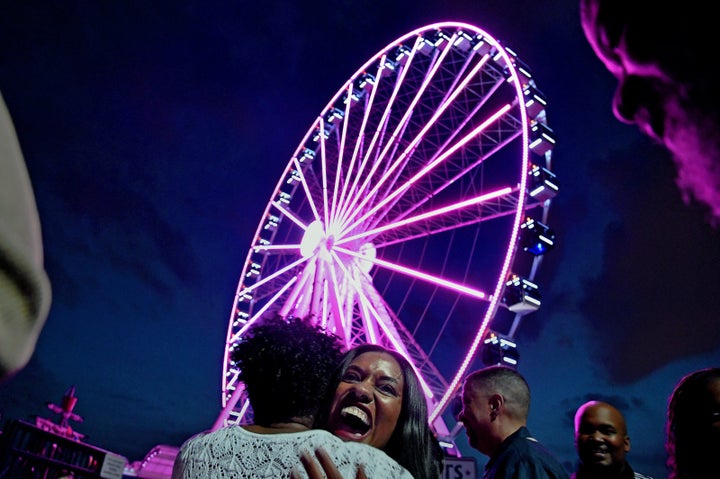Being pregnant in 2018 comes with a lot of fanfare ― at least, that’s how it seems on social media.
First, there’s the pregnancy announcement. Then there are the weekly progress photos, tracking the growth of the “bump” and comparing the unborn baby to increasingly large pieces of produce. In this Pinterest-loving world, baby showers seem to be more elaborate than ever, and some grandparents-to-be are even having their own showers. It feels like a requirement to take epic, stylized maternity photos. And of course, there’s the so-called gender reveal.
If you’ve ever browsed YouTube, Facebook or Instagram, you’ve inevitably come across photos or videos of expectant parents’ gender reveals. Generally, these occasions are full-on parties centered around a special moment when the parents cut into a cake, pop balloons filled with confetti, hit a powder-filled baseball or even set off fireworks to find out if they are having a boy or a girl.

The History
While some couples may have hosted similar gatherings many years ago, the notion of a gender reveal party as a widespread phenomenon is a more recent development. But when did this gain traction as a trend?
“We can trace gender reveal videos first being uploaded to YouTube back to 2009,” Stephanie Shih, a public affairs manager at the company, told HuffPost.
“The trend of gender reveal videos began to emerge on YouTube in mid-2011 and continued to grow in terms of uploads and views from then on,” she added. “In 2017, YouTube saw a 60 percent increase in views for gender reveal videos compared to 2016.”
Indeed, Google Trends indicates a similar timeline, with interest in the term first appearing around 2010. The top accompanying search terms include “party,” “cake” and “ideas.” While the trend is most popular in the United States, there’s search interest in Puerto Rico, Australia, Canada and New Zealand as well.
Google Trends uses numbers 1-100 to indicate search interest, with 100 indicating peak popularity for the term.
Countless gender reveals have reached viral status. According to Shih, some of the most-viewed gender reveal videos on YouTube include a mom of six boys reacting to the news she’s having a girl, a popular vlogger couple’s confetti reveal, a pair of siblings helping their parents share the sex of their unborn twins and a surprise triplet announcement. Celebrities like Kate Hudson and Jason Aldean have also gotten in on the fun.
Reasons For The Rise
There are many explanations for the increasing popularity of gender reveals. With medical advancements in recent years, parents can find out the sex of their unborn child earlier in the pregnancy and with more accuracy than in the past. It’s no secret people love the opportunity to throw a themed party. And in a time when the world seems full of bad news, gender reveals can be occasions to share moments of joy.
“I think it allows people to get creative and express themselves through revealing their gender. It is so much fun to plan and exciting for all friends and family involved,” said Melissa Van, who hosted a gender reveal party with her husband at a local park. They opened a box filled with blue balloons in front of a beautiful mountain backdrop.
“It just seemed so much better than a blanket announcement,” she added. “It’s our first child, and we plan to go all out!”
For many, the gender reveal represents the end of a painful battle with infertility.

“After going through four IVFs it was refreshing and exciting to get news surrounded by family and friends instead of at a doctor’s office. It was finally some fun after the storm,” Allison Falcon told HuffPost.
“I struggled through four years of infertility and had many friends and family that supported my husband and I through that,” Ashley Riester Laganiere explained. “The gender reveal was the first time we all got to get together and celebrate his life and the end of that struggle. It also was our way of thanking everyone for being by our side for so many years.”
There’s also the power of social media and the blogosphere. Prominent bloggers and YouTubers, in particular, like to share every step of their pregnancy journey, and gender reveals are no exception. Mediums like Facebook, Instagram, Pinterest and YouTube make even more people aware of and likely to participate in this ritual.
“The gender-reveal party is but one example of the growing trend in making the private events of parenthood public,” Carly Gieseler, an assistant professor at the City University of New York, wrote in an academic paper about this phenomenon. In this sense, gender reveals have spread in a similar way to Pinterest-y pregnancy announcements and milk bath maternity photos. The more they show up on social media, the more common they become.
“Arguably, the gender-reveal trend speaks to deeper needs than an excuse for a party,” Gieseler wrote. “This need may correlate with our increased capacity for sharing, our competitive consumerism, or our drive to permanently articulate moments so unfathomable or temporal.”
Gender reveals can certainly have a competitive element, which is only amplified by social media. As the practice has become more widespread, parents seem hellbent on one-upping each other with more elaborate and over-the-top celebrations.

Expectant parents in Louisiana incorporated a live alligator into the big surprise, and a Texas couple used a private plane. Another pair asked singer Brad Paisley to do the honors onstage in the middle of a concert, and one mom-to-be dyed her hair. And of course, there are the colorful reveals featuring smoke bombs, cars and even fire hoses.
“The reveals get crazier and crazier. It really is a fascinating thing, but it’s directly tied to social media,” Gieseler told CNN in June.
The Backlash
The trend has also faced backlash for promoting rigid gender norms at a time when many activists are fighting for greater gender diversity and inclusion.
Undoubtedly, gender reveals perpetuate gender stereotypes, from the emphasis on pink and blue as distinctly “girl” and “boy” colors to the themes like “Guns or Glitter,” “Staches or Lashes,” “Rifles or Ruffles,” “Wheels or Heels,” “Tractors or Tiaras,” “Pistols or Pearls,” “Touchdowns or Tutus” and “Hair Bows or Bow Ties.”
After all, who’s to say a baby boy won’t grow up to love tutus, glitter and the color pink, or a baby girl won’t develop an interest in sports, tractors and bow ties as she gets older? Critics say these parties ascribe to the limits of a gender binary, excluding those who are intersex, transgender, nonbinary or otherwise don’t neatly fit into those two categories.
“Besides the level of self-indulgence required to throw a party just to celebrate one part of a fetus’s anatomy, this only seems like a foreboding sign of how much pressure these parents will put on their kid in the future to live up to gender stereotypes,” Alex Bollinger wrote on LGBTQ Nation.
“As a parent of a transgender child, I cringe at gender reveal parties,” Mary Anne McGrory told HuffPost.
The term “gender reveal” is also a misnomer. The subject of these reveals is the baby’s sex, not gender identity.
Of course, parents who choose to have gender reveals do not necessarily wish to force these norms on their children and may very well be supportive of a gender nonconforming child. Still, critics have noted that this ritual does not do the gender inclusivity cause any favors.
“Despite the progress made in the past few years regarding gender identity, parties that reassert the significance of a gender-reveal (or more accurately, sex-identification) are placing significance on distinctions in sex and reifying language that we have tried to move beyond,” Gieseler wrote in her report, which also explores the commoditization of parenthood and narcissism inherent in the trend.
In 2014, Miss Manners even knocked the gender reveal party, writing, “Not everyone is as excited as you are about every detail of your child’s life, let alone the pre-life. It is best to know this now, before you start going on social media announcing baby’s first spit-up or throwing parties for when he or she sleeps through the night.”
Still, for many, the gender reveal is simply a fun, somewhat silly custom ― not to be taken too seriously. These occasions also lend themselves to moments of hilarity when things go wrong.
And while many people detest those “I’m just here for the sex” T-shirts and cakes that often pop up at gender reveals, at least they use the more accurate term.